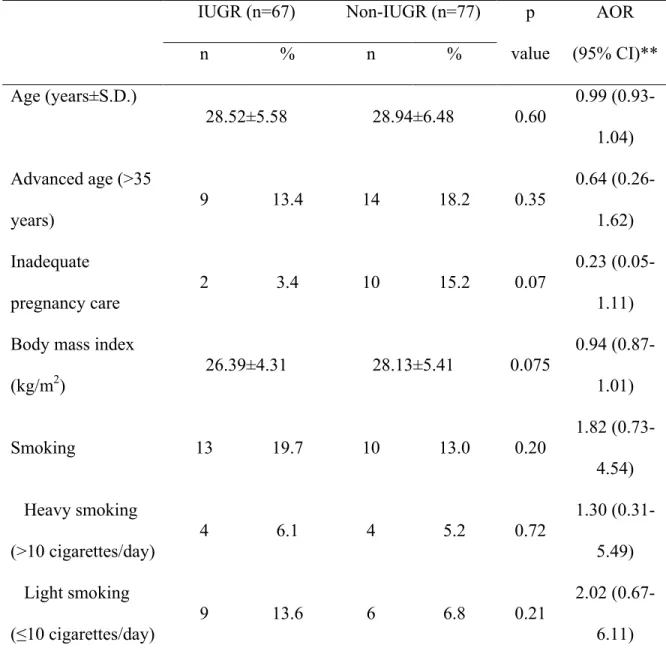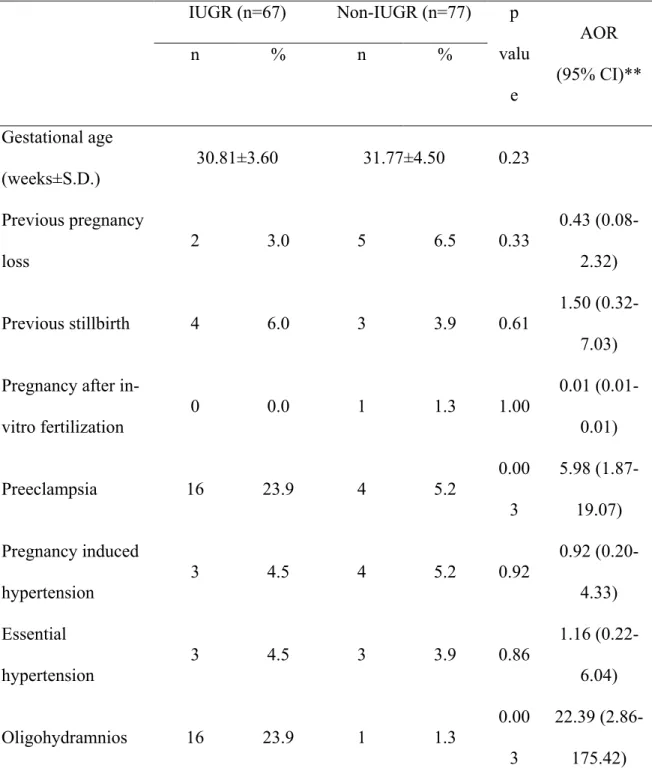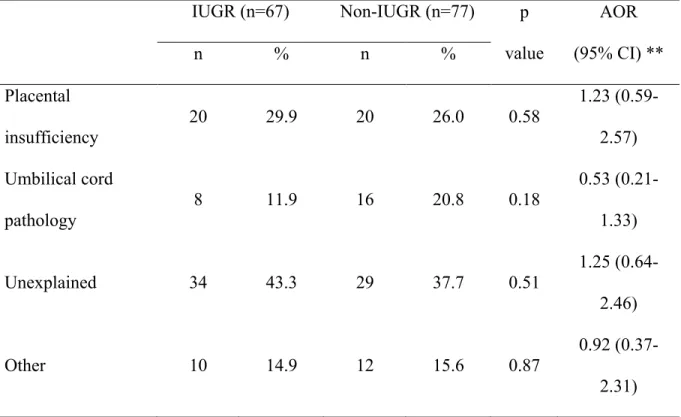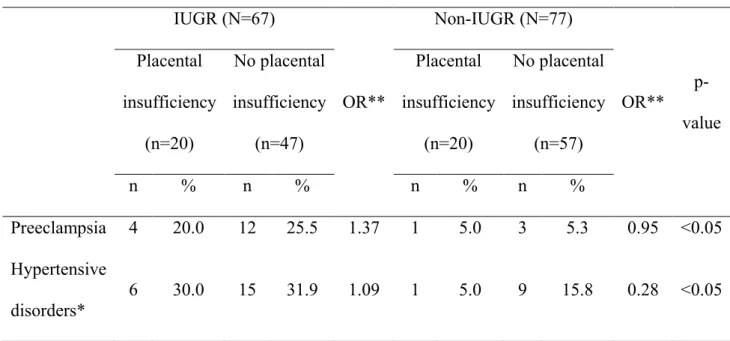Intrauterine growth retardation in case of a stillbirth: how does it really matter?
Norbert Pásztor M.D.a, Zoltan Kozinszky M.D., Ph.D. b, Attila Keresztúri M.D., Ph.D.a
aDepartment of Obstetrics and Gynecology, University of Szeged, Hungary (Semmelweis 1, Szeged, Hungary, H-6725);
bDepartment of Obstetrics and Gynecology, Blekinge Hospital, Karlskrona, Sweden
Short title: Maternal hypertension is associated with IUGR stillbirth
Corresponding author: Zoltan Kozinszky M.D., Ph.D.
Utövägen 10/A, Karlskrona, Sweden, SE-37137
Department of Obstetrics and Gynecology, Blekinge Hospital, Karlskrona, Sweden Telephone: +46730720835
E-mail: kozinszky@gmail.com
Pásztor Norbert; Kozinszky Zoltan; Keresztúri Attila
Intrauterine growth retardation in case of a stillbirth: how does it really matter?
JOURNAL OF REPRODUCTIVE MEDICINE (0024-7758 ): 63 3 pp 299-304 (2018)
Synopsis
Maternal hypertensive disorders are the only distinguishable clinical features between growth restricted and non-IUGR stillbirths.
Abstract
Objective: Growth restriction is associated with increased risk of stillbirth. Our purpose was to compare the autopsy and placental histopathological examination results of intrauterine growth retardation (IUGR) and non-IUGR fetal deaths.
Study Design: Postmortem examination and obstetric risk of stillbirths from 1996 to 2012 were reviewed retrospectively at the Department of Obstetrics and Gynecology, University of Szeged. Forty-seven percent of the 153 stillbirths out of the 34,673 births were registered as IUGR.
Results: Umbilical cord anomaly as an underlying cause of death was significantly less prevalent among IUGR stillbirths and predominantly occurred in the late pregnancy.
Oligohydramnios (p<0.001) and maternal hypertensive diseases (<0.05) were associated with greater risk of IUGR among stillbirths. Placental insufficiency was more associated to preeclampsia (p<0.05) and maternal hypertensive diseases (p<0.001) among IUGR-group than in the non-IUGR group. Any degree of placental degeneration was not a distinguishable factor for growth retardation.
Conclusion: A more intensive surveillance of IUGR and high-risk pregnancies could lead to an improvement in stillbirth rate, however, the prevention strategies of IUGR stillbirths remains questionable because of very prematurity.
Keywords: autopsy; placental histology; stillbirth; intrauterine growth retardation;
obstetric risk
Introduction
The intrauterine growth retardation (IUGR) is a condition that affects 5-10% of all pregnancies1 and is associated for a significant proportion of stillbirth.2 The IUGR fetus is not able to reach its full growth potential, usually because of underlying placental pathology.3,4 Recognition of growth restriction is still a challenge despite of widely use of ultrasound examinations and a higher detection of IUGR cases would be necessary by the elaboration of new clinical protocols (fetal kick charts, fundal height measurements, serial ultrasound examinations) in order to decrease stillbirth rates.3
It is known that there is an increase in the risk of stillbirth in IUGR fetuses compared to non-IUGR fetuses at all gestational ages.5 It is supposed that the predominant cause of death in IUGR is the severe placental insufficiency leading to multiorgan failure and cardiovascular collapse.6,7 However, the differences in risk factors and causes of intrauterine death (IUFD) between IUGR and non-IUGR stillbirths have not received much attention yet.
Our aim, therefore, was to evaluate, the differences in the risk factors, autopsy and placental histopathological results between the intrauterine fetal deaths (IUFDs) with IUGR and without growth restriction.
Material and Methods
The placental histopathology and fetal autopsy findings concerning all stillbirths occurred at the Department of Obstetrics and Gynecology, University of Szeged, Hungary from January 1996 to April 2012 were reviewed. Stillbirth was defined as fetal
death prior to delivery. According to the Hungarian regulations,8 only stillbirths with weight ≥500 g and/or ≥24 gestational weeks were selected . Gestational age was determined using an algorithm combining last menstrual period and early ultrasound data. The clinical data were collected from the databases of the Department of Obstetrics and Gynecology, University of Szeged. Autopsies and placental histopathological examinations performed by the pathologists proved the cause of fetal death in most of the cases, but the clinical course was also considered.9 Subsequently, the cause of stillbirth was determined by a consensus between the gynecologists on the basis of relevant clinical findings and the pathologists reporting the autopsy and placental histopathological results. Intrauterine growth retardation (IUGR) was determined as fetal weight below the 10th percentile, using the Hungarian birth weight centiles. Placental insufficiency was defined as inadequate spiral artery remodeling and/or spiral artery pathology leading to an uteroplacental vascular insufficiency, such as 1) acute placental infarction (>20%) and/or 2) calcification (>20%), or 3) a placental hematoma with intervillous thrombosis. The placental insufficiency group comprised also morphologic abnormalities that arise because of abnormal developmental processes and acquired placenta parenchyma disorders of the villi/intervillous space (>20%) (as classified at the Department of Pathology, University of Szeged). Placental lesions were also recorded by the pathologists, even when these histopathological observations did not reach a level of 25% and were not so severe as to cause stillbirth.10 Infectious cause of death was defined as an autopsy with evidence of organ involvement with an organism and/or histological placental examination with infectious findings.11 Umbilical cord occlusion was diagnosed as a cause of death when a constricting knot/loop around the neck could be recognized with a histopathological evidence of chronic fetal vascular
obstruction.12 The body mass index (BMI) was considered as the body weight (kg) per height (m2) at delivery. Hypertensive disorders were defined as presence of preeclampsia or pregnancy induced hypertension or essential hypertension.
Comparison between variables was constructed by binary logistic regression to evaluate the effect of the fetal and placental weight and ratio on various study factors adjusted for gestational age (GA) at stillbirth to eliminate the confounding effect of GA.
Logistic regression coefficient values and equations depending on GA were also calculated when the effect of the study factor was significant on the fetal growth. The Mantel-Haenszel test was applied to compare frequency of placental insufficiency between IUGR and non-IUGR groups in relation to other factors. Analyses were performed using SPSS 17.0 (SPSS Statistics, Chicago, IL, USA). A p value of <0.05 was required to reject the null hypothesis.
Results
From January 1996 to December 2013, 144 singleton stillbirths out of 36,447 births were registered at the Department of Obstetrics and Gynecology, University of Szeged, demonstrating a stillbirth rate of 3.95‰.
Clinical details concerning IUGR stillbirths and non-IUGR stillbirths are presented in Table 1. Among 144 stillbirths, 67 (46.53%) had the birth weight below the 10th percentile, whereas 77 (53.47%) were non-IUGR. There was no significant difference in regards of age between the mothers of stillbirths with IUGR and those with non-IUGR. Surprisingly, inadequate pregnancy care was more common both in the non-IUGR-group (15.2%) and in the IUGR-group (3.4%). Mothers with IUGR stillbirth
had slightly lower BMI than those with non-IUGR stillbirth, although the difference was not significant. Interestingly, the rate of smokers was considerably higher among mothers with pregnancies affected by IUGR as compared to non-IUGR pregnancies, but the difference was not significant. The grade of tobacco use did not differ in the birth weight groups.
As regards the gestational age at delivery, mothers of stillbirths born with a low birth weight had a minimally shorter pregnancy (30.81±3.60 weeks) than their counterparts with appropriate weight for gestational age (31.77±4.50 weeks). Only small proportions of mothers had previous unfavourable obstetric outcome and the frequency in-vitro fertilization precedent pregnancy was also notably low in both study groups.
Oligohydramnios (23.9% vs. 1.3%, p < 0.001) and hypertensive disorders (32.9% vs. 10.4%, p < 0.05) were significantly more frequent among the IUGR- pregnancies. Furthermore, preeclampsia alone was also significantly more prevalent among IUGR (23.9%) than non-IUGR cases (5.2%, p = 0.003). The incidences of diabetes mellitus and gestational diabetes mellitus were lower in the IUGR group (1.5%
vs. 2.6% and 3.0% vs.9.2%, respectively), without significant differences. Placental weight was almost doubled in the non-IUGR group as compared to those in the IUGR- group (Table 2).
IUGR was not associated significantly with placental insufficiency (29.9% vs.
26.0%), even though there was a significant difference in any grade of the placental degenerations among IUGR and non-IUGR pregnancies (68.7% vs 48.1%, p=0.018).
The incidence of the umbilical cord pathology was not significantly different in the two study groups (11.9% vs. 20.8%). Furthermore, there was no significant difference in the
occurrences of other causes or unexplained cases between the IUGR and non-IUGR pregnancies. No case of intrapartum fetal death was recorded (Table 3).
Significantly more cases with placental insufficiency had preeclampsia relative to the cases with no placental insufficiency in the IUGR group (OR: 1:37) than did have those in the non-IUGR group (OR: 0.95). This relationship was more pronounced in hypertensive disorders among the patients with IUGR than those who had no IUGR (Table 4).
Discussion
Intrauterine growth restriction (IUGR) remains one of the main challenges in maternity care and about half of the stillbirths are growth restricted. To our knowledge this is the first study demonstrating the comparison of the background of the IUGR and non-IUGR stillbirths. In our study, a slightly higher frequency of fetal growth restriction was observed among stillbirths (47%) than that found in other studies (35%-43%).13-15
It is well known that IUGR is often related to sonographically detected placenta insufficiency.6,16 However, one of our major results is that a histologically verified placental insufficiency is not dominating among IUGR-stillbirths. Surprisingly, a substantial proportion of the non-IUGR stillbirths also exhibit insufficiency background, which could be explained by several issues. Population charts were applied in our study in order to detect restricted fetal growth which could be inferior to customized growth charts.2,3,17 Furthermore, the comparable placental insufficiency rates in the two study groups could be explained by the fact that a considerable proportion of the non-IUGR fetuses might restricted customized growth potential. In
addition, the rate of IUGR among stillbirths could be influenced by the clinical management of the high-risk pregnancies.
It is documented that the placental surface area is the principal determinant of adequate fetal oxygenation18,19 and it is a cornerstone that the fetal birthweight is directly correlated with placental weight.20 This is confirmed in our study among stillbirths, even though the placental insufficiency/any degree of placental degeneration is not significantly more prevalent in the IUGR group compared to non-IUGR counterparts. This paradoxon could be explained by the fact that decreased placental weight is more linked to restricted growth than histologically demonstrable lesions,21 but further research is required for clarification.
In our analysis, oligohydramnios and preaeclamspia are strongly correlated with IUGR stillbirths, which is in accordance with studies on live births.22,23 According to Salafia et al.,18 placental insufficiency is not associated with preeclampsia neither in the IUGR nor in the non-IUGR group. However if IUGR goes together with preeclampsia the risk of placental insufficiency is significantly elevated compared to cases with non- IUGR accompanied with preeclampsia, and this was more so in case of all hypertensive diseases. This can be explained with the observation of Egborn,24 who confirmed the association between abnormal placental morphology in early-onset preeclampsia. In our stillbirth population, the majority of cases were with early-onset type preeclampsia.
The prevalence of the abnormality of the umbilical cord is 16.3% in our study group, however, the literature data show wide range of 5.2%-42%.13,25,26 To our knowledge, there has not been any report focusing on umbilical cord pathology in stillbirths with growth retardation. One of our most striking results is that fatal compromise of umbilical circulation contributes a significantly less stillbirth among
IUGR pregnancies than among those with normal birth weight. As in other reports,25 the fatal compromise of umbilical circulation occurs mostly in the third trimester, whereas the stillbirths in the IUGR-group occur mostly in the earlier period of the pregnancy.
Another possible explanation could be that the small fetuses exhibit a movement pattern with lower intensity and amplitude.27 Our data suggest that the stillbirth caused by umbilical cord abnormalities is predisposed in an unselected pregnancy population and the fatal episode might happen accidentally (68% had no obstetric risk), whereas the high risk pregnancies associated with IUGR are examined and screened more intensively, leading to a decrease in cord complication.
Unfortunately, the options of intrauterine treatment of IUGR foetuses are very limited. Thus, in most cases, the obstetric management has to aim on surveillance of foetal health and on finding the optimal time of delivery. Generally, to avoid stillbirth, the IUGR foetuses have to be delivered extremely preterm and then the obstetrician faces the task of balancing the risk of intrauterine asphyxia eventually resulting in stillbirth against the risks of extremely early prematurity (25.0% in our dataset). IUGR is often related with the malfunctioning placenta and is asymptomatic. The detection of IUGR fetuses necessitates a screening of the whole pregnant population with Doppler ultrasound and biometry or only target populations (e.g., pregnancies with declining symphysis–fundal height or high-risk pregnancies). If the IUGR is related to a maternal disorder (i.e. pre-eclampsia or maternal hypertension), then obstetric management could theoretically prevent stillbirths. In our population, all of IUGR-stillbirths had at least one obstetric risk which could adjust stillbirth, whereas the corresponding data was 45.7% for non-IUGR pregnancies, although 30 mothers (19.6%) had not attended regular prenatal care schedules. Another major challenge is the surveillance of those
fetuses apparently with a weight over 10th percentile, but with a decreasing growth potential, which is unknown in our population.
The biometric evaluation of foetal growth is mainly useful in identifying SGA foetuses; for timing of delivery, methods evaluating foetal physiological functions, for example, Doppler examination of foetal and placental haemodynamics, have a higher predictive value. Still, the degree of foetal ‘smallness’ should be taken in account when making decisions on obstetric management of IUGR foetuses.
Conflict of Interest Statement
The authors declare no conflict of interest.
References
1. Frøen F
growth in sudden intrauterine unexplained death Acta Obstet Gynecol Scand.
2004;83:801-7.
2.
2010;53:673-80.
3.
surveillance, diagnosis, and management 300.
4. Korteweg FJ, Gordijn SJ, Timmer A, Holm JP, Ravisé JM, Erwich JJ: A placental cause of intra-uterine fetal death depends on the perinatal mortality classification system used. Placenta. 2008;29:71-80.
5. Pilliod RA, Cheng YW, Snowden JM, Doss AE, Caughey AB: The risk of intrauterine fetal death in the small-for-gestational-age fetus. Am J Obstet Gynecol. 2012;207:318.e1-6.
6. Nardozza LM, Junior EA, Barbosa MM, Caetano AC, Lee DJ, Moron AF: Fetal growth restriction: current knowledge to the general Obs/Gyn. Arch Gynecol Obstet. 2012;286:1-13.
7. Regnault TR, Galan HL, Parker TA, Anthony RV: Placental development in normal and compromised pregnancies – a review. Placenta. 2002; 23 Suppl A:S119-29.
8. Papp Z. Szülészet-nőgyógyászati protokoll [Protocol in Obsetrics and Gynecology] (in Hungarian) Budapest: Golden Book Kiadó, 2002.
9. Siebert JR: Perinatal, fetal and embryonic autopsy. In: Potter’s pathology of the fetus, infant and child, 2nd edn. Gilbert-Barness E. Philadelphia, Elsevier, 2007, 695–740.
10. Morrison I, Olsen J: Weight-specific stillbirths and associated causes of death: an analysis of 765 stillbirths. Am J Obstet Gynecol. 1985;152:975-80.
11. Korteweg FJ, Gordijn SJ, Timmer A, Erwich JJ, Bergman KA, Bouman K, Ravise JM, Heringa MP, Holm JP: The Tulip classification of perinatal mortality:
introduction and multidisciplinary inter-rater agreement. Br J Obstet Gynaecol.
2006;113:393-401.
12.
histologic criteria for diagnosis of cord accident: sensitivity and specificity.
13.
14. Evers AC, Nikkels P, Brouwers HA, Boon J, Egmond-Linden A, Hart C, Snuif YS, Sterken-Hooisma S, Bruinse HW, Kwee A: Substandard care in antepartum term stillbirths: prospective cohort study. Acta Obstet Gynecol Scand.
2011;90:1416-22.
15. Gardosi J, Kady SM, McGeown P, Francis A, Tonks A: Classification of stillbirth by relevant condition at death (ReCoDe): population based cohort study.
2005;331:1113-7.
16. Marsal K: Intrauterine growth restriction: Investigation and management. Curr Opin Obstet Gynecol. 2002;14:127-35.
17. Gardosi J, Chang A, Kalyan B, Sahota D, Symonds EM: Customised antenatal growth charts. Lancet. 1992;339:283-7.
18.
19. Teasdale F: Idiopathic intrauterine growth retardation: histomorphometry of the human placenta. Placenta. 1984;5:83-92.
20.
gestational age infants revisite 2001;22:399-404.
21.
related to maternal anthropometry and placental volume 2004;58:894-900.
22.
severe maternal phenotype in the setting of early onset pre-eclampsia? A retrospective study.
23.
with intra-uterine fetal growth restriction complicated with and without oligohydramnios.
24. Egbor M, Ansari T, Morris N, Green CJ, Sibbons PD: Morphometric placental villous and vascular abnormalities in early- and late-onset pre-eclampsia with and without fetal growth restriction. Br J Obstet Gynaecol. 2006;113:580-9.
25. Parast MM, Crum CP, Boyd TK:
26. Baergen RN: Cord abnormalities, structural lesions, and cord ‘‘accidents’’. Semin Diagn Pathol. 2007;24:23-32.
27. Robertson WB, Brosens I, Dixon G: Uteroplacental vascular pathology. Eur J Obstet Gynecol Reprod Biol. 1975;5:47-65.
Table 1. Baseline characteristics of the mothers affected by stillbirth born with intrauterine growth retardation (IUGR) stillbirths (n=67) and those with non-IUGR stillbirths (n=77) at the Department of Obstetrics and Gynaecology, University of Szeged, Hungary between January 1st, 1996 and December 31st, 2012.*
IUGR (n=67) Non-IUGR (n=77) p value
AOR (95% CI)**
n % n %
Age (years±S.D.)
28.52±5.58 28.94±6.48 0.60 0.99 (0.93- 1.04) Advanced age (>35
years) 9 13.4 14 18.2 0.35 0.64 (0.26-
1.62) Inadequate
pregnancy care 2 3.4 10 15.2 0.07 0.23 (0.05-
1.11) Body mass index
(kg/m2) 26.39±4.31 28.13±5.41 0.075 0.94 (0.87- 1.01)
Smoking 13 19.7 10 13.0 0.20 1.82 (0.73-
4.54) Heavy smoking
(>10 cigarettes/day) 4 6.1 4 5.2 0.72 1.30 (0.31- 5.49) Light smoking
(≤10 cigarettes/day) 9 13.6 6 6.8 0.21 2.02 (0.67- 6.11)
* Binary logistic regression adjusted for gestational age.
Table 2. Obstetric characteristics of the mothers affected by stillbirth born with intrauterine growth retardation (IUGR) (n=67) and those with non-IUGR stillbirths (n=77) at the Department of Obstetrics and Gynaecology, University of Szeged, Hungary between January 1st, 1996 and December 31st, 2012.*
IUGR (n=67) Non-IUGR (n=77) p valu
e
AOR (95% CI)**
n % n %
Gestational age
(weeks±S.D.) 30.81±3.60 31.77±4.50 0.23 Previous pregnancy
loss 2 3.0 5 6.5 0.33 0.43 (0.08-
2.32)
Previous stillbirth 4 6.0 3 3.9 0.61 1.50 (0.32- 7.03) Pregnancy after in-
vitro fertilization 0 0.0 1 1.3 1.00 0.01 (0.01- 0.01)
Preeclampsia 16 23.9 4 5.2 0.00
3
5.98 (1.87- 19.07) Pregnancy induced
hypertension 3 4.5 4 5.2 0.92 0.92 (0.20-
4.33) Essential
hypertension 3 4.5 3 3.9 0.86 1.16 (0.22-
6.04)
Oligohydramnios 16 23.9 1 1.3 0.00 22.39 (2.86-
Any type of
diabetes mellitus 3 4.5 9 11.8 0.11 0.34 (0.09- 1.31)
Placental weight 258.0±128.18 391.0±162,0 <0.0 01
0.99 (0.98- 0.99)
* Binary logistic regression adjusted for gestational age.
** Adjusted odds ratio, 95% confidence interval
Table 3. Categories of the causes of death of stillbirths by the mothers with IUGR stillbirths (n=67) and non-IUGR stillbirths (n=77) at the Department of Obstetrics and Gynaecology, University of Szeged, Hungary between January 1st, 1996 and December 31st, 2012.*
IUGR (n=67) Non-IUGR (n=77) p value
AOR (95% CI) **
n % n %
Placental
insufficiency 20 29.9 20 26.0 0.58 1.23 (0.59-
2.57) Umbilical cord
pathology 8 11.9 16 20.8 0.18 0.53 (0.21-
1.33)
Unexplained 34 43.3 29 37.7 0.51 1.25 (0.64-
2.46)
Other 10 14.9 12 15.6 0.87 0.92 (0.37-
2.31)
* Binary logistic regression adjusted for gestational age.
** Adjusted odds ratio, 95% confidence interval
Table 4. Mantel-Haenszel test on placental insufficiency as cause IUGR (N=67)
OR**
Non-IUGR (N=77)
OR** p- value Placental
insufficiency (n=20)
No placental insufficiency
(n=47)
Placental insufficiency
(n=20)
No placental insufficiency
(n=57)
n % n % n % n %
Preeclampsia 4 20.0 12 25.5 1.37 1 5.0 3 5.3 0.95 <0.05 Hypertensive
disorders* 6 30.0 15 31.9 1.09 1 5.0 9 15.8 0.28 <0.05
* All type of hypertensive disorders during pregnancy
** OR: odds ratio



